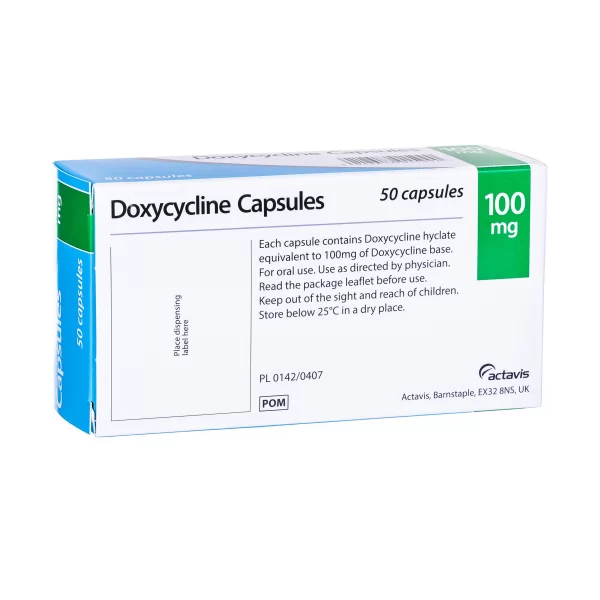
Doxycycline
Doxycycline - 200mg
| Product | Per Pill | Savings | Per Pack | Order |
|---|---|---|---|---|
| 30 pills | $1.54 | $46.28 | Buy Now | |
| 60 pills | $1.00 | $32.31 | $92.56 $60.25 | Buy Now |
| 90 pills | $0.82 | $64.63 | $138.85 $74.22 | Buy Now |
| 120 pills | $0.73 | $96.94 | $185.13 $88.19 | Buy Now |
| 180 pills | $0.65 | $161.57 | $277.70 $116.13 | Buy Now |
| 270 pills | $0.59 | $258.52 | $416.56 $158.04 | Buy Now |
| 360 pills | $0.56 | $355.46 | $555.41 $199.95 | Buy Now |
Doxycycline - 100mg
| Product | Per Pill | Savings | Per Pack | Order |
|---|---|---|---|---|
| 30 pills | $1.19 | $35.80 | Buy Now | |
| 60 pills | $0.71 | $29.29 | $71.59 $42.30 | Buy Now |
| 90 pills | $0.54 | $58.58 | $107.39 $48.81 | Buy Now |
| 180 pills | $0.38 | $146.44 | $214.78 $68.34 | Buy Now |
| 270 pills | $0.33 | $234.30 | $322.16 $87.86 | Buy Now |
| 360 pills | $0.30 | $322.16 | $429.55 $107.39 | Buy Now |
Overview of Doxycycline
1. General Introduction
Doxycycline is a broad-spectrum antibiotic belonging to the tetracycline class. It is widely used to treat various bacterial infections, including respiratory tract infections, urinary tract infections, skin infections, and sexually transmitted diseases. Doxycycline works by inhibiting bacterial protein synthesis, thereby preventing bacterial growth and replication.
2. Primary Purpose
The primary purpose of doxycycline is to manage and treat bacterial infections by stopping the growth and replication of bacteria. It is commonly used for conditions such as pneumonia, bronchitis, sinusitis, urinary tract infections (UTIs), skin infections, and certain sexually transmitted infections like chlamydia and gonorrhea.
3. Key Benefits and Properties
Doxycycline offers several key benefits and properties that make it an effective treatment option for bacterial infections:
- Broad-Spectrum Activity: Effective against a wide range of gram-positive and gram-negative bacteria.
- Anti-Inflammatory Properties: Helps reduce inflammation in conditions like acne and rosacea.
- Good Oral Bioavailability: Absorbed well from the gastrointestinal tract, providing effective systemic treatment.
- Long Half-Life: Allows for once or twice daily dosing, improving adherence to treatment.
4. Efficacy
Clinical studies have demonstrated the efficacy of doxycycline in treating a variety of bacterial infections. Patients treated with doxycycline typically experience rapid improvement in symptoms and successful eradication of the infection. Its broad-spectrum activity and favorable safety profile make it a reliable choice for many bacterial infections.
5. Safety and Tolerability
Doxycycline is generally well-tolerated by most patients, with a favorable safety profile. Common side effects include nausea, diarrhea, and photosensitivity. These side effects are usually mild and temporary. However, serious side effects can occur, such as esophageal irritation and ulceration, severe skin reactions, and rare cases of intracranial hypertension. Regular monitoring by a healthcare provider is recommended to ensure safety during treatment.
6. Convenience of Dosing
Doxycycline offers convenient dosing options, typically administered once or twice daily. The dosage varies based on the type and severity of the infection. This flexibility in dosing allows for personalized treatment plans that optimize efficacy and minimize side effects.
Indications for Use of Doxycycline
1. Conditions Treated by Doxycycline
Doxycycline is primarily indicated for the treatment of various bacterial infections, including:
- Respiratory tract infections (pneumonia, bronchitis, sinusitis)
- Urinary tract infections (UTIs)
- Skin and soft tissue infections (acne, rosacea)
- Sexually transmitted diseases (chlamydia, gonorrhea)
- Tick-borne diseases (Lyme disease, Rocky Mountain spotted fever)
- Malaria prophylaxis and treatment
2. Symptoms and Indications
- Respiratory Tract Infections: Relieves symptoms such as cough, chest pain, shortness of breath, and fever.
- Urinary Tract Infections: Reduces symptoms like frequent urination, burning sensation during urination, and abdominal pain.
- Skin Infections: Reduces redness, swelling, pain, and discharge associated with bacterial skin infections and inflammatory acne.
- Sexually Transmitted Diseases: Treats infections like chlamydia and gonorrhea, reducing symptoms such as discharge and pain.
Dosage and Administration of Doxycycline
1. Dosage and Intake
- Initial Dosage: The typical starting dose for doxycycline varies based on the type and severity of the infection. For most infections, the recommended dose for adults is 100 mg every 12 hours on the first day, followed by 100 mg once daily or 50 mg every 12 hours.
- Maintenance Dosage: Depending on the patient’s response and the specific infection being treated, the dose may be adjusted.
2. Timing of Administration
- Regular Doses: Doxycycline should be taken once or twice daily, at evenly spaced intervals, to maintain consistent levels in the body. It should be taken with a full glass of water to prevent esophageal irritation.
- Missed Dose: If a dose is missed, it should be taken as soon as remembered unless it is close to the time for the next dose. In that case, skip the missed dose and resume the regular dosing schedule.
3. Additional Recommendations
- With or Without Food: Doxycycline can be taken with or without food, but taking it with food may reduce the risk of gastrointestinal upset.
- Avoid Lying Down: Do not lie down immediately after taking doxycycline to prevent esophageal irritation and ulceration.
Mechanism of Action of Doxycycline
1. Description of Mechanism
Doxycycline works by inhibiting bacterial protein synthesis. It binds to the 30S ribosomal subunit of the bacterial ribosome, preventing the addition of amino acids to the growing peptide chain. This action inhibits the growth and replication of bacteria, leading to their death.
2. Biochemical Processes
- Inhibition of Protein Synthesis: Doxycycline binds to the bacterial ribosome, blocking the translocation of peptides and inhibiting protein synthesis.
- Bacteriostatic Effect: By preventing protein synthesis, doxycycline stops the growth and replication of bacteria, leading to their eventual death.
3. Physiological Effects
- Bacterial Cell Death: The inhibition of protein synthesis leads to bacterial cell death, effectively treating the infection.
- Symptom Relief: Rapid bacterial eradication results in quick relief from infection symptoms.
Composition of Doxycycline
1. General Introduction
Doxycycline is composed of both active and inactive ingredients that work together to provide its therapeutic effects.
2. Active Ingredients
- Doxycycline Hyclate: The active component in doxycycline, responsible for its antibacterial effects.
3. Inactive Ingredients
- Excipients: These may include substances such as magnesium stearate, microcrystalline cellulose, and other agents that help form the tablet or capsule and ensure its stability and efficacy.
Side Effects of Doxycycline
1. General Introduction
While doxycycline is generally well-tolerated, it can cause side effects in some patients. Awareness of these potential side effects helps in managing them effectively.
2. Possible Side Effects
- Common Side Effects: Nausea, diarrhea, photosensitivity (increased sensitivity to sunlight), and esophageal irritation.
- Less Common Side Effects: Some patients may experience headache, dizziness, or yeast infections.
3. Frequency and Severity
- Mild to Moderate: Most side effects are mild to moderate in severity and tend to diminish as the body adjusts to the medication.
- Severe: Rarely, severe side effects such as severe skin reactions, intracranial hypertension, and esophageal ulceration may occur. Immediate medical attention is required in such cases.
Prevention of Side Effects
1. General Introduction
Preventing side effects involves following the prescribed dosage and usage guidelines carefully.
2. Tips to Prevent Side Effects
- Follow Dosage Instructions: Adhering to the prescribed dosage reduces the risk of side effects.
- Stay Hydrated: Drinking plenty of water can help prevent dehydration and reduce gastrointestinal side effects.
- Avoid Excessive Sun Exposure: Use sunscreen and wear protective clothing when outdoors to prevent photosensitivity reactions.
3. Recommendations for Improving Tolerance
- Gradual Adjustment: If side effects are bothersome, consult a healthcare provider for potential dose adjustment.
- Report Adverse Effects: Reporting any adverse effects to a healthcare provider ensures timely management and adjustment of the treatment plan.
Contraindications for Doxycycline
1. General Introduction
Certain conditions and factors may contraindicate the use of doxycycline.
2. Conditions and Diseases
- Pregnancy and Breastfeeding: Doxycycline is contraindicated during pregnancy and breastfeeding due to the risk of permanent tooth discoloration and bone development issues in the fetus or infant.
- Children Under 8 Years: Doxycycline should not be used in children under 8 years old due to the risk of permanent tooth discoloration.
- Allergy to Tetracyclines: Doxycycline is contraindicated in patients with a known allergy to tetracyclines.
3. Warnings for Different Patient Groups
- Pregnant Women: Should avoid doxycycline due to potential risks to the fetus.
- Patients with Liver Disease: Those with severe liver impairment should use doxycycline with caution and under medical supervision.
Warnings and Precautions
1. General Introduction
Taking certain precautions can minimize risks associated with doxycycline use.
2. Important Warnings
- Avoid Sun Exposure: Due to the risk of photosensitivity, patients should avoid excessive sun exposure and use sunscreen.
- Monitor for Intracranial Hypertension: Patients should report symptoms such as headache, blurred vision, and dizziness.
3. Measures for Minimizing Risks
- Regular Monitoring: Regular follow-up visits with a healthcare provider to monitor progress and side effects.
- Communicate Concerns: Patients and caregivers should communicate any concerns or adverse effects to their healthcare provider promptly.
Missed Dose
1. What to Do if a Dose is Missed
If a dose of doxycycline is missed, it should be taken as soon as remembered unless it is close to the time for the next dose. In that case, skip the missed dose and resume the regular dosing schedule.
2. Tips for Adhering to Dosing Schedule
- Set Reminders: Use alarms or reminders to remember to take the medication.
- Keep a Log: Maintain a log or chart to track dosing times.
Drug Interactions
1. Introduction
Doxycycline can interact with other medications, affecting its efficacy and safety.
2. Examples of Interactions
- Antacids: Concurrent use with antacids containing aluminum, calcium, or magnesium can reduce the absorption of doxycycline.
- Iron Supplements: Iron supplements can also reduce the absorption of doxycycline.
- Warfarin: Doxycycline can increase the effects of warfarin, increasing the risk of bleeding.
3. How to Avoid Negative Interactions
- Inform Healthcare Providers: Always inform healthcare providers about all medications being taken.
- Follow Guidelines: Adhere to medical guidelines and avoid unapproved combinations of medications.
Overdose
1. Symptoms of Overdose
Symptoms of a doxycycline overdose can include severe nausea, vomiting, diarrhea, and increased intracranial pressure.
2. Actions to Take in Case of Overdose
- Seek Immediate Medical Attention: Contact emergency services or go to the nearest emergency room.
- Do Not Induce Vomiting: Unless instructed by a healthcare provider, do not attempt to induce vomiting.
Pharmacokinetics of Doxycycline
1. Absorption
Doxycycline is well-absorbed from the gastrointestinal tract, with peak plasma concentrations occurring within 2 to 3 hours after oral administration.
2. Distribution
Doxycycline is widely distributed throughout the body, including the lungs, liver, kidneys, and prostate.
3. Metabolism
Doxycycline is not extensively metabolized in the liver, with the majority of the dose excreted unchanged in the feces and urine.
4. Elimination
The elimination half-life of doxycycline is approximately 18 to 22 hours. The drug and its metabolites are excreted mainly in the feces and urine.
Dosage Forms
1. Available Forms and Dosages
Doxycycline is available in various forms, including capsules, tablets, and oral suspensions. Dosages typically range from 50 mg to 100 mg per unit.
2. Advantages of Dosage Forms
- Capsules and Tablets: Convenient for routine use and easy to dose accurately.
- Oral Suspensions: Suitable for children and those who have difficulty swallowing pills.
Pregnancy and Breastfeeding
1. Safety of Use
The safety of doxycycline during pregnancy and breastfeeding has specific considerations:
- Pregnancy: Doxycycline is contraindicated during pregnancy due to the risk of permanent tooth discoloration and bone development issues in the fetus.
- Breastfeeding: Doxycycline is excreted in breast milk and can affect the nursing infant, so it should be avoided during breastfeeding.
2. Recommendations for Pregnant and Nursing Mothers
- Not Recommended: Doxycycline should not be used by pregnant or breastfeeding women.
Storage Conditions
1. Storage Recommendations
Doxycycline should be stored at room temperature, away from light and moisture. Keep it out of reach of children and pets.
2. Temperature and Other Conditions
- Optimal Temperature: Store doxycycline at a temperature between 20°C to 25°C (68°F to 77°F).
- Avoid Humidity: Keep the medication in a dry place to maintain its efficacy.
Clinical Trials and Efficacy
1. Overview of Clinical Studies
Clinical trials have demonstrated the efficacy of doxycycline in treating a wide range of bacterial infections. These studies confirm its effectiveness in reducing infection symptoms and eradicating the causative bacteria.
2. Main Results and Findings
- Infection Control: Significant reduction in symptoms and successful eradication of bacterial infections.
- Broad-Spectrum Activity: Effective against various gram-positive and gram-negative bacteria.
Conclusion
1. Summary of Doxycycline
Doxycycline is a potent and versatile antibiotic for managing bacterial infections. Its benefits include broad-spectrum activity, rapid onset of action, and convenient dosing options. Doxycycline offers a valuable treatment option for patients with various types of bacterial infections.
2. Main Benefits and General Recommendations
- Benefits: Effective in treating a wide range of bacterial infections, well-tolerated, convenient dosing options.
- Recommendations: Follow prescribed dosages, monitor for side effects, and consult healthcare providers regularly for optimal management of bacterial infections.





